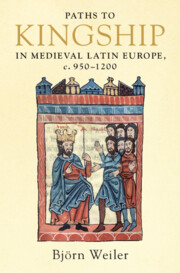Book contents
- Paths to Kingship in Medieval Latin Europe, c. 950–1200
- Paths to Kingship in Medieval Latin Europe, c. 950–1200
- Copyright page
- Contents
- Maps
- Acknowledgements
- Abbreviations
- Timeline
- Introduction
- Part I Foundations
- Part II Creating Kingship
- Part III Succession
- Part IV Election
- Part V Inauguration
- 9 Enthroning the King
- 10 Beyond Enthronement
- Conclusion
- Select Reading
- Index
9 - Enthroning the King
from Part V - Inauguration
Published online by Cambridge University Press: 24 September 2021
- Paths to Kingship in Medieval Latin Europe, c. 950–1200
- Paths to Kingship in Medieval Latin Europe, c. 950–1200
- Copyright page
- Contents
- Maps
- Acknowledgements
- Abbreviations
- Timeline
- Introduction
- Part I Foundations
- Part II Creating Kingship
- Part III Succession
- Part IV Election
- Part V Inauguration
- 9 Enthroning the King
- 10 Beyond Enthronement
- Conclusion
- Select Reading
- Index
Summary
Chapter 9 discusses royal inaugurations. It starts out with three particularly well-documented case studies: the enthronement of Emperor Conrad II in 1024, of King Richard Lionheart of England in 1189 and of King Alexander III of Scotland in 1249. The chapter draws attention to the variety of practices adopted in high medieval Europe, and shows that inaugurations cannot be reduced to just one event, but that they include a series of interlocking acts, such as the inauguration itself, but also processions and feasts. Each stage was designed to reinforce basic principles of the royal office, to ensure the continuity of the realm and to display the right order of the world. Particular attention is paid to the process of inauguration as reflecting the status not only of the ruler, but also of his leading subjects, and to the relationship between the ruler and the divine. Kingship was inherently sacred and sacral, but that meant something quite different in a high medieval context than in the modern imagination.
Keywords
- Type
- Chapter
- Information
- Paths to Kingship in Medieval Latin Europe, c. 950–1200 , pp. 309 - 350Publisher: Cambridge University PressPrint publication year: 2021

